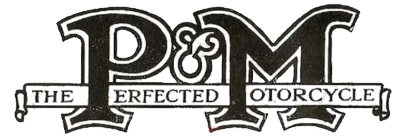


The company started out in Cleckheaton, Yorkshire, as Phelon and Moore, derived from the names of the founders, Joah Carver Phelon and Richard Moore, who became partners in 1903.
Unable to produce the machine himself, his first design was sold to Humber for royalty payments. After Rayner died in a car accident, Phelon was joined by Richard Moore in 1904 to form P and M.
1904 The P and R engine was further developed and the all-chain drive was replaced by a simple two-speed gear system with clutches. Their first offering was a two-speed forecar but as this was not popular, the partners' attention soon turned to motorcycles. The first models were typical of those times and were based on bicycles with engines. Before long the name was recognised in the field of hill climbs and trials.
1907 Only the 3.5hp model was now listed, and it was the mainstay of the company until the 1920s.
1910 Cycle and Motorcycle Exhibition
Phelon and Moore, Ltd.
12 Mortimer Street, London, W. Stand No. 87.
The 3.5 H.P. model for the coming season embodies a free engine and two-speed gear.
The valves are mechanically operated and the drive is by means of a chain. A feature of the machine is the very low saddle position,
which is now so popular. The motor is provided with a starting handle, and the clutch is so gentle in action that the machine 'nets away
very sweetly and without any jerk or risk of stopping the motor. Of course, spring forks are employed. In the case of the 2 H.P. model a
two-speed gear is also provided, but in this machine the motor has automatic inlet valves. In other respects it follows very much upon
the lines of the more powerful type, having a free engine and handle starting. Chain transmission is also employed. A special feature is
that this machine can be obtained in all- weather finish, a fact which must appeal to enthusiastic riders. A special Colonial model is
built by the firm, and this is provided with 2in. heavy " Kempshall " tyres, all weather finish, and a crankcase clearance of ..in.
Extra large petrol and oil reservoirs are also fitted. On all the machines a special fixing is employed for the mudguards, and the front
wheels are removable in a moment, so that tyre troubles lose a good deal of their terrors.
World War I. That model was taken on by the Air Force and used by their despatch riders. A V-twin engine had been on the drawing board, but this was dropped with the outbreak of war.
Post War. The company still produced just one model.
Increased engine capacity (555 c.c.) and a four-speed gear should more than ever ensure the success of the P. & M. as a go anywhere dual-purpose mount.
Forecast and Guide to Olympia 1921
In general appearance the P. and M. has been improved also, and an unusual fitment (which should form part of every sidecar machine) is the ratchet brake, by means of which the outfit may be left standing on a hill without the necessity of "scotching."
The Motor Cycle, November 24th, 1921
Sources: Graces Guide
If you have further information or a query related to this page, please contact us